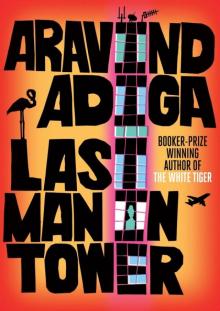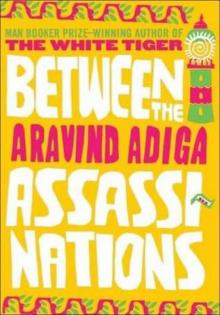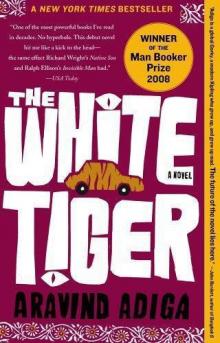- Home
- Aravind Adiga
Last Man in Tower
Last Man in Tower Read online
Last Man in Tower
Also by Aravind Adiga:
The White Tiger
Between the Assassinations
Last Man in Tower
ARAVIND ADIGA
First published in Great Britain in hardback and airport and export trade paperback in 2011 by Atlantic Books, an imprint of Atlantic Books Ltd.
Copyright © Aravind Adiga, 2011
The moral right of Aravind Adiga to be identified as the author of this work has been asserted by him in accordance with the Copyright, Designs and Patents Act of 1988.
All rights reserved. No part of this publication may be reproduced, stored in a retrieval system or transmitted in any form or by any means, electronic, mechanical, photocopying, recording or otherwise, without the prior permission of both the copyright owner and the above publisher of this book.
This novel is entirely a work of fiction. The names, characters and incidents portrayed in it are the work of the author’s imagination and not to be construed as real. Any resemblance to actual persons, living or dead, events or localities, is entirely coincidental.
10 9 8 7 6 5 4 3 2 1
A CIP catalogue record for this book is available from the British Library.
Hardback ISBN: 978 1 84887 516 6
Trade Paperback ISBN: 978 1 84887 517 3
eBook ISBN: 978 1 84887 786 3
Printed in Great Britain
Atlantic Books
An imprint of Atlantic Books Ltd
Ormond House
26–27 Boswell Street
London WC1N 3JZ
www.atlantic-books.co.uk
Table of Contents
Cover
Title Page
Copyright
Dedication
Map
Book One How the Offer was Made
11 May
12 May
13 May
Book Two Mr Shah Explains His Proposal
14 May
18 May
Book Three Four or Five Seconds of Feeling Like a Millionaire
4 June
Book Four The Rains Begin
19 June
20 June
21 June
25 June
29 June
Book Five The End of an Opposition Party
3 July
6 July
Book Six Fear
15 July
21 July
23 July
24 July
31 July
1 August
2 August
3 August
6 August
17 August
Book Seven Last Man in Tower
2 Septemper
3 Septemper
4 Septemper
Book Eight Deadline
29 Septemper
30 Septemper
1 October
2 October
3 October
Book Nine The Simplest of Things
4 October
5 October
7 October
Epilogue Murder and Wonder
15 December
16 December
23 December
Acknowledgements
To my fellow commuters on the Santa Cruz–Churchgate local line
A NOTE ON MONEY
A lakh is 100,000 rupees, equivalent to around £1,400 or $2,200.
A crore is 10,000,000 rupees, equivalent to around £140,000 or $220,000.
So Mr Shah’s offer to the members of Vishram Society would translate into a typical windfall of around £210,000 or $330,000 per family.
The average per capita annual income in India in 2008–9 was 37,490 rupees, around £500 or $800.
PLAN OF VISHRAM SOCIETY (TOWER A)
VAKOLA, SANTA CRUZ (EAST), MUMBAI – 400055
Ground floor:
0A
the security guard’s personal room
0B
allotted to the Secretary of the Society for official work, with an alcove for the cleaning lady to store her broom, disinfectant, and mopping cloth
0C
Felicia Saldanha, 49, and her daughter Radhika, 20; Mr Saldanha, an engineer, is said to work in Vizag
1st floor:
1A
Suresh Nagpal, 54, timber merchant, and wife Mohini, 53
1B
Georgina Rego, 48, social worker, and son Sunil, 14, and daughter Sarah, 11
1C
C. L. Abichandani, hardware specialist, 56, his wife Kamini, 52, and daughters Kavita, 18, and Roopa, 21
2nd floor:
2A
Albert Pinto, 67, retired accountant for the Britannia Biscuit Company, and wife Shelley, 64
2B
Deepak Vij, 57, businessman, his wife Shruti, 43, and daughter Shobha, 21
2C
Ramesh Ajwani, real-estate broker, 50, his wife Rukmini, 47, and sons Rajeev, 13, and Raghav, 10
3rd floor:
3A
Yogesh A. Murthy (known as ‘Masterji’), retired schoolteacher, 61, now living alone after the recent death of his wife Purnima
3B
Given on rent to Ms. Meenakshi, possibly a journalist, single woman of about 25. Owner Shiv Hiranandani (known as ‘Import-Export’) lives in Khar West
3C
Sanjiv Puri, 54, accountant, his wife Sangeeta, 52, and son Ramesh, 18, afflicted with Down’s syndrome
4th floor:
4A
Ashvin Kothari, 55, the Secretary of the Society, occupation unknown, his wife Renuka, 49, and son Siddharth (known as ‘Tinku’), 10
4B
George Lobo, 45, respectable chemist, his wife Carmina, 40, and daughter Selma, 19
4C
Ibrahim Kudwa, 49, internet-store owner, his wife Mumtaz, 33, and children Mohammad, 10, and Mariam, 2
5th floor:
5A
Given on rent to Mr Narayanswami, 35, working in an insurance company in the Bandra-Kurla Financial Centre. Wife said to be in Hyderabad. (Owner Mr Pais lives in Abu Dhabi)
5B
Sudeep Ganguly, 43, proprietor of a stationery shop in Bandra (East), his wife Sharmila, 41, and son Anand, 11
5C
left empty, on request of owner Mr Sean Costello, after the suicide of his son Ferdinand, who jumped from the terrace of the building; owner currently in Qatar, working as chef for American fast-food company
Other regulars:
Mary, 34, the khachada-wali, or cleaning lady; and Ram Khare, 56, the security guard; maids and cooks are employed in most of the households
If you are inquiring about Vishram Society, you will be told right away that it is pucca – absolutely, unimpeachably pucca. This is important to note, because something is not quite pucca about the neighbourhood – the toenail of Santa Cruz called Vakola. On a map of Mumbai, Vakola is a cluster of ambiguous dots that cling polyp-like to the under-side of the domestic airport; on the ground, the polyps turn out to be slums, and spread out on every side of Vishram Society.
At each election, when Mumbai takes stock of herself, it is reported that one-fourth of the city’s slums are here, in the vicinity of the airport – and many older Bombaywallahs are sure anything in or around Vakola must be slummy. (They are not sure how you even pronounce it: Va-KHO-la, or VAA-k’-la?) In such a questionable neighbourhood, Vishram Society is anchored like a dreadnought of middle-class respectability, ready to fire on anyone who might impugn the pucca quality of its inhabitants. For years it was the only good building – which is to say, the only registered co-operative society – in the neighbourhood; it was erected as an experiment in gentrification back in the late 1950s, when Vakola was semi-swamp, a few bright mansions amidst mangroves and malarial clouds. Wild boar and bands of dacoits were ru
moured to prowl the banyan trees, and rickshaws and taxis refused to come here after sunset. In gratitude to Vishram Society’s pioneers, who defied bandits and anopheles mosquitoes, braved the dirt lane on their cycles and Bajaj scooters, cut down the trees, built a thick compound wall and hung signs in English on it, the local politicians have decreed that the lane that winds down from the main road to the front gate of the building be called ‘Vishram Society Lane’.
The mangroves are long gone. Other middle-class buildings have come up now – the best of these, so local real-estate brokers say, is Gold Coin Society, but Marigold, Hibiscus, and White Rose grow and grow in reputation – and with the recent arrival of the Grand Hyatt Hotel, a five-star, the area is on the verge of ripening into permanent middle-class propriety. Yet none of this would have been possible without Vishram Society, and the grandmotherly building is spoken of with reverence throughout the neighbourhood.
It is, strictly speaking, two distinct Societies enclosed within the same compound wall. Vishram Society Tower B, which was erected in the late 1970s, stands in the south-east corner of the original plot: seven storeys tall, it is the more desirable building to purchase or rent in, and many young executives who have found work in the nearby Bandra-Kurla financial complex live here with their families.
Tower A is what the neighbours think of as ‘Vishram Society’. It stands in the centre of the compound, six storeys tall; a marble block set into the gate-post says in weathered lettering:
THIS PLAQUE WAS UNVEILED BY SHRI KRISHNA MENON, THE HONOURABLE DEFENCE MINISTER OF INDIA, ON 14 NOVEMBER 1959, BIRTHDAY OF OUR BELOVED PRIME MINISTER, PANDIT JAWAHARLAL NEHRU.
Here things become blurry; you must get down on your knees and peer to make out the last lines:
… HAS ASKED MENON TO CONVEY HIS FONDEST HOPE THAT VISHRAM SOCIETY SHOULD SERVE AS AN EXAMPLE OF ‘GOOD HOUSING FOR GOOD INDIANS’.
ERECTED BY:
MEMBERS OF THE VISHRAM SOCIETY CO-OPERATIVE HOUSING SOCIETY FULLY REGISTERED AND INCORPORATED IN THE CITY OF BOMBAY 14-11-1959
The face of this tower, once pink, is now a rainwater-stained, fungus-licked grey, although veins of primordial pink show wherever the roofing has protected the walls from the monsoon rains. Every flat has iron grilles on the windows: geraniums, jasmines, and the spikes of cacti push through the rusty metal squares. Luxuriant ferns, green and reddish green, blur the corners of some windows, making them look like entrances to small caves.
The more enterprising of the residents have paid for improvements to this shabby exterior – hands have scrubbed around some of the windows, creating aureoles on the façade, further complicating the patchwork of pink, mildew-grey, black, cement-grey, rust-brown, fern-green, and floral red, to which, by midday, are added the patterns of bedsheets and saris put out to dry on the grilles and balconies. An old-fashioned building, Vishram has no lobby; you walk into a dark square entranceway and turn to your left (if you are, or are visiting, Mrs Saldanha of 0C), or climb the dingy stairwell to the homes on the higher floors. (An Otis lift exists, but unreliably so.) Perforated with eight-pointed stars, the wall along the stairwell resembles the screen of the women’s zenana in an old haveli, and hints at secretive, even sinister, goings-on inside.
Outside, parked along the compound wall are a dozen scooters and motorbikes, three Maruti-Suzukis, two Tata Indicas, a battered Toyota Qualis, and a few children’s bicycles. The main feature of this compound is a three-foot-tall polished black-stone cross, set inside a shrine of glazed blue-and-white tiles and covered in fading flowers and wreaths – a reminder that the building was originally meant for Roman Catholics. Hindus were admitted in the late 1960s, and in the 1980s the better kind of Muslim – Bohra, Ismaili, college-educated. Vishram is now entirely ‘cosmopolitan’ (i.e. ethnically and religiously mixed). Diagonally across from the black Cross stands the guard’s booth, on whose wall Ram Khare, the Hindu watchman, has stencilled in red a slogan adapted from the Bhagavad Gita:
I was never born and I will never die; I do not hurt and cannot be hurt; I am invincible, immortal, indestructible.
A blue register juts out of the open window of the guard’s booth. A sign hangs from the roof:
ALL VISITORS MUST SIGN THE LOG BOOK AND PROVIDE CORRECT ADDRESS AND MOBILE PHONE NUMBER BEFORE ENTRY
BY ORDER – THE SECRETARY VISHRAM CO-OPERATIVE HOUSING SOCIETY
A banyan tree has grown through the compound wall next to the booth. Painted umber like the wall, and speckled with dirt, the stem of the tree bulges from the masonry like a camouflaged leopard; it lends an air of solidity and reliability to Ram Khare’s booth that it perhaps does not deserve.
The compound wall, which is set behind a gutter, has two dusty signs hanging from it:
VISIT SPEED-TEK CYBER-CAFÉ. PROPRIETOR IBRAHIM KUDWA
RENAISSANCE REAL ESTATE. HONEST AND RELIABLE. NEAR VAKOLA MARKET
The evening cricket games of the children of Vishram have left most of the compound bare of any flowering plants, although a clump of hibiscus plants flourishes near the back wall to ward off the stench of raw meat from a beef shop somewhere behind the Society. At night, dark shapes shoot up and down the dim Vishram Society Lane; rats and bandicoots dart like billiard balls struck around the narrow alley, crazed by the mysterious smell of fresh blood.
On Sunday morning, the aroma is of fresh baking. There are Mangalorean stores here that cater to the Christian members of Vishram and other good Societies; on the morning of the Sabbath, ladies in long patterned dresses and girls with powdered faces and silk skirts returning from St Antony’s church will crowd these stores for bread and sunnas. In a little while, the smell of boiling broth and spicy chicken wafts out from the opened windows of Vishram Society into the neighbourhood. At such an hour of contentment, the spirit of Prime Minister Nehru, if it were to hover over the building, might well declare itself satisfied.
Yet Vishram’s residents are the first to point out that this Society is nothing like paradise. You know a community by the luxuries it can live without. Those in Vishram dispense with the most basic: self-deception. To any inquiring outsider they will freely admit the humiliations of life in their Society – in their honest frustration, indeed, they may exaggerate these problems.
Number one. The Society, like most buildings in Vakola, does not receive a 24-hour supply of running water. Since it is on the poorer, eastern side of the train tracks, Vakola is blessed only twice a day by the Municipality: water flows in the taps four to six in the morning, and 7.30 p.m. to 9 p.m. The residents have fitted storage tanks above their bathrooms, but these can only hold so much (larger tanks threaten the stability of a building this ancient). By five in the evening the taps have usually run dry; the residents come out to talk. A few minutes after seven thirty, the reviving vascular system of Vishram Society ends all talk; water is coursing at high pressure up the pipes, and kitchens and bathrooms are busy places. The residents know that their evening washing, bathing, and cooking all have to be timed to this hour and a half when the pressure in the taps is the greatest; as do ancillary activities that rely on the easy availability of running water. If the children of Vishram Society could trace a path back to their conceptions, they would generally find that they occurred between half past six and a quarter to eight.
The second problem is the one that all of Santa Cruz, even the good part west of the railway line, is notorious for. Acute at night, it also becomes an issue on Sundays between 7 and 8 a.m. You open your window and there it is: a Boeing 747, flying right over your building. The residents insist that after the first month, the phrase ‘noise pollution’ means nothing to you – and this is probably true – yet rental prices for Vishram Society and its neighbours are at least a fourth lower because of the domestic airport’s proximity.
The final problem, existential in nature, is spelled out by the glass-faced noticeboard:
NOTICE
Vishram Co-operative Hsg Society Ltd, Tower A Minutes of the special meeting held on Saturd
ay, 28 April
Theme: Emergency nature of repairs is recognized
As the quorum was insufficient, even on such an urgent issue, the meeting had to be adjourned for half an hour; the adjourned meeting commenced at about 7.30 p.m.
ITEM NO. 1 OF THE AGENDA:
Mr Yogesh Murthy, ‘Masterji’, (3A) suggested that the minutes of the last meeting of ‘A’ Building be taken as read as the copy of the minutes had already been circulated to all members. It was unanimously agreed that the said minutes be taken as read.
ITEM NO. 2 OF THE AGENDA:
At the outset, Masterji (3A as above) expressed serious concern about the condition of the Society Building and emphasized the need to start repair work immediately in the interest of the members’ safety and the safety of their children; most of the members gathered expressed similar…
… meeting was finally concluded about 8.30 p.m. with a vote of thanks to the chair.
Copy (1) To Members of Vishram Co-op Hsg Society Ltd, Tower A
Copy (2) To Mr A. Kothari, Secretary, Vishram Co-op Hsg Society Ltd, Tower A
Pinned behind this notice are older notices of a similar nature. After more than four decades of monsoons, erosion, wind-weathering, air pollution, and the gentle but continual vibrations caused by the low-flying planes, Tower A stands in reasonable chance of complete collapse in the next monsoon.
And yet no one, either in Vishram Society or in the neighbourhood at large, really believes that it will fall.
Vishram is a building like the people living in it, middle class to its core. Improvement or failure, it is incapable of either extremity. The men have modest paunches, wear checked polyester shirts over white banians, and keep their hair oiled and short. The older women wear saris, salwar kameez, or skirts, and the younger ones wear jeans. All of them pay taxes, support charities, and vote in local and general elections.

 Last Man in Tower
Last Man in Tower Selection Day
Selection Day Between the Assassinations
Between the Assassinations The White Tiger
The White Tiger The White Tiger: A Novel
The White Tiger: A Novel